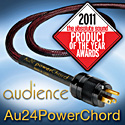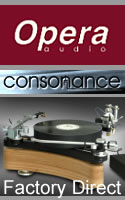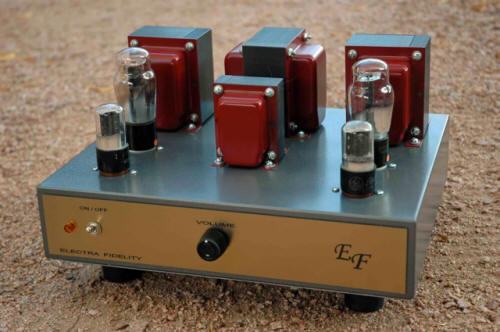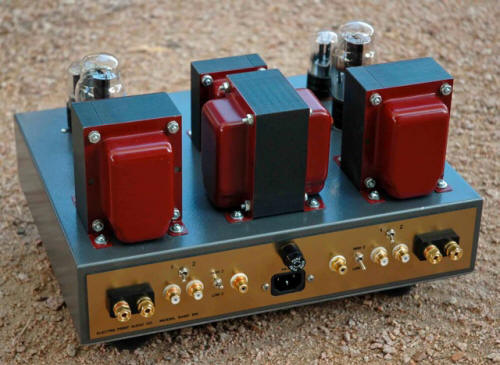|
|
You are reading the older HTML site
Positive Feedback ISSUE 59
electra-fidelity Silver 45 SE Integrated Amplifier as reviewed by John Hoffman
Tourists from around the world are drawn to a city in the desert called Las Vegas. Perhaps it is the lure of the opulent casinos and the promise of a big payoff at the roulette wheel or slot machine. For others, the incredible shows and performers are what they come to see. The acrobats in the Cirque du Soleil shows are fantastic, as are magicians such as David Copperfield or Criss Angel. The night life at the clubs of Las Vegas are a sirens' call to many, and this is a place where the rich and famous of American society can be seen. Even the audiophile can be drawn to Las Vegas. Every January the Consumer Electronic Show is held in the Convention Center, the Hilton, and the Venetian. There is one more site of interest to the avid audio hobbyist in Las Vegas, and that is Electra-Print Audio. Jack Elliano founded Electra Print-Audio in 1977, and became firmly established in the market place due to his skill of winding custom transformers. The black art of producing an exceptional transformer is a long protected secret, which only a select few are privy to the inner details of this craft. Paul Bennett taught Jack how to wind wide bandwidth transformers, and his designs are influenced by the work of Eurcell Harrison. Jacks formal education is as an electrical engineer with a high point in his career being his involvement on the NASA Gemini project. Jack's contribution was in the research and circuit design of radar and tracking systems. The field of Ham Radio also played a significant role in Jack's early education and is the bedrock for his interest in audio; which became solidified during the 1970's when he worked in Hollywood recording studios. Mr. Elliano brings a diverse set of skills to the work bench, which results in a line of products that offer both uncommon value, and a remarkable presentation of music. Electra-Print circuit designs have been innovative and in some ways unusual, such as the 300DRD amplifier, which forgoes coupling capacitors on the signal path to the power tubes, but instead uses large resistors to shunt the signal through the amplifier. Another unique design from Jack is the 211 Class A2 amplifier, which is capable of producing in excess of 40-watts a channel. This is quite an accomplishment considering that a conventional circuit using a 211 output tube has a range of 12 to 20 watts in Class A operation. The PVA passive pre-amplifier is a deceptively simple and cost effective product, that contains a pair of nickel core transformers to ensure a constant output impedance at any volume knob position. Every product developed by Jack Elliano is firmly grounded in electrical theory. With Jacks designs, there are no claims of suspending the laws of physics, the discovery of unheard of materials, or any other type of audio foolery that often permeates this hobby. In order to focus more of his time on designing and manufacturing amplifier, in January 2011 Jack established Electra-Fidelity Amplification. This offshoot of Electra-Print allows Jack to fully develop and manufacture products based on his circuit designs and custom wound wound transformers. The first product developed for the new company is the Silver 45 SE (Special Edition) amplifier. This is a limited edition amplifier that silver wiring in the transformers and sells for $3995. The standard model is the 45 CU, which uses all copper wire transformers, and has a price tag of $2495. Under the Electra-Fidelity line there are plans to roll out a revision of the 300DRD amplifier, an OTL pre-amplifier, and a set of 40 watt push pull mono-block amplifiers. Clearly Jack has a great deal of enthusiasm for this project. To help move things along, Tony Chipelo has come on board to handle the sales and marketing end of the company. I have spent a great deal of time talking with Tony and Jack to gain an understanding of what makes the Silver 45 SE such a remarkable amplifier, and they are a friendly and helpful guys. The Silver 45 SE amplifier is built around more of a traditional audio circuit, which is a bit of a surprise as I have come to expect a high degree of creativity from Jacks designs. Still, there are certain aspects of this amplifier that are unusual, although there are practical reasons for these design choices. The output transformers are from the Partial Stranded Secondary series, but have been custom designed specifically for the 45 tube. A typical 45 circuit will measure a minimum of 5% distortion at the mid power band, while the Silver 45 SE will only have a 1.2% distortion measurement. The input stage of the amplifier uses the PVA circuit, although the transformers have been upgraded to solid core silver wire. The use of silver wire in both the output transformers and the input stage result higher levels of resolution and transparency. The output transformers come with single impedance secondary output windings, which provides wide bandwidth and remarkably flat frequency response. The 45 circuit designed by Jack is optimized for tubes produced between 1929 and 1959, which includes both ST and Globe types. Tube rolling is possible with this amplifier, but the lowest distortion levels are going to be achieved by using tubes specified by Jack. One point to note, apparently there is feedback that the EML 45 tube performs quite well in this amplifier, and is an acceptable choice if a person requires a new production tube. The pre-driver tube is the 6SN7, which is often considered to be one of the finest triode tubes produced. This is a large family of tubes, which allows for a wide array of voicing possibilities when tube rolling. Although it should be noted that certain 6SN7 variant tubes do not have electrical characteristics that meet all of the circuits requirements, so less than ideal results may occur if used in this amplifier. Power supply regulation is accomplished by a solid-state devices. The amplifier contains an auto bias circuit, which frees the owner from having to periodically check and adjust the bias current on the output tubes. The amplifier will come supplied with NOS tubes, which Electra-Fidelity has a reserve set aside for these amplifiers. Rumor has it that Jack bought these tubes new when he was a teenager, with paper route money. However, he will neither confirm or deny these allegations.
There is a single volume control knob and power switch located on the face of the amplifier. Two sets of RCA input jacks are located on the back panel. Either pair can be configured for a high or low impedance setting, which means the amplifier can be properly matched to either solid-state or vacuum tube source components. There is a second pair of toggle switches located on the back panel that allow the amplifier to be placed in a high/low pass mode. The high side engages a 100Hz/6dB per octave crossover, and is used to feed the speaker the information from 100Hz and up. The low pass position returns the amplifier to full range operation. There is an additional set of RCA jacks that allow the input signal to pass through the amplifier, which that allows for the use of a powered subwoofer. This output operates independent of the high/low pass settings, so a subwoofer can be integrated with the main speakers in either configuration. The Silver 45 SE is built on a .062 aluminum chassis. This is a unit body construction, where all side panels are seamlessly welded, and the bottom plate is held in place by screws. This provides a solid platform to support the chunky transformers used on this amplifier. The front and back plates are laser cut acrylic with a metal coating finish. The chassis is painted a gray hammer tone, which is quite durable. The bell ends of the transformers can be painted either black or maroon. There is an optional wood end panel upgrade available, and the current woods to pick from are cherry or walnut. My reference electronics consist of a custom built Electra-Print 300B based amplifier and PVA pre-amplifier, which allows for an interesting comparison to the Silver 45 SE. The Silver 45 SE has the advantage of the upgraded PSS output transformers, and the solid silver core wire in the transformers located in the PVA stage. The 300B based amplifier contains an op-amp pre-driver stage that results in a remarkably low noise floor and wide bandwidth frequency response. The differences between the two circuits, and the parts contained in each amplifier should result in significant differences in sound quality, even though both components came from the hand of the same designer. With a power output level of 1.7 watts per channel, the Silver 45 SE amplifier requires a high efficiency speaker. Efficiency levels need to be of 97 to 98dB or higher, which means the typical monkey coffin monitor style speaker will not get the job done. In listening sessions Jack used a pair of Sonist Concerto 4 speakers, which are 97dB efficient, and he was pleased with the results of this combination. Fortunately, the Sachiko Double Horn speakers I have on hand are also up to the task, although they fall into the bottom range of what is acceptable. The Sachiko are fitted with a pair of first generation Fostex 208 Sigma drivers and come in at 98dB efficiency. Since this is a single driver speaker, the absence of crossover parts eliminates any parasitic losses of power. The 3dB down point of this speaker is 50Hz, which is typical for a full range/high efficiency design. Since the Silver 45 SE has the subwoofer pass through feature, I can also install an Infinity Cascade 15 powered sub into the system, and the end result is a full range speaker system. The defining attribute of the Silver 45 SE is an even handed tonal balance, which is a characteristic that very few tube amplifiers are capable of achieving. Now many amplifiers are more than capable of creating a homogenized sound, which creates the illusion of even tonal balance by stripping the tonal color from the music. This amplifier preserves the dynamic contrasts present at the micro level of the music and maintains the focus and timing aspects of the recording. The end result is that instruments and performers are properly balanced, with a presentation that sounds natural and unfatigued. Until this experience with the Silver 45 SE, I believed the Electra-Print 300B I currently own had remarkably even and wide bandwidth, especially when I compared it to other SET amplifiers on the market. However the differences between my amplifier and Jack's latest creation are significant, and the Silver 45 SE handily bests its sibling in every facet of tone and resolution. The opening drum line on "Battle of Waterloo" by Skweez the Weezle [A Celtic Band; Self Released STWCD01] has remarkable texture and feel to the sound, I can clearly hear the impact of the hands on the drum skin. An acoustic guitar joins the drummer, and the strummed chords are lively and engaging, yet decay in a completely natural manner. Then a violin joins in; it has a sharp and aggressive tonal quality, yet the sound is never harsh or offensive. Since this is a Celtic band, it is only natural to include a bagpipe in this song and halfway through the pipes interject its distinctive personality onto the music. This is a dynamic and forceful instrument, yet it is skillfully intertwined with the violin part and the interplay between the two instruments is captivating. The Silver 45 SE amplifier presents each instrument in its full musical glory, yet it still blends the final sound together in the manner which the band strived for. Too often audio equipment dissects the music, and the goals of the artist are sacrificed to the gods of imaging, sound stage, and detail. This does not happen with this Electra-Fidelity amplifier, for the music maintains all its splendor. Do not let my previous statement mislead you. The Silver 45 SE excels at developing cavernous space within my listening room. Instruments and performers are given proper size and are solidly formed in the stage. The Electra-Fidelity amplifier clearly places the listener in a mid hall position, and while it may not bowl you over initially, it will unveil its strengths as you continue to spend time with the amplifier. With classical music, the arc of the orchestra is clearly defined with a remarkable degree of depth. Each section of instruments is also clearly defined, and are are properly spaced. The opening of Tchaikovsky Symphony #4 [Andante sostenuto, moderato con anima; London Festival Symphony EXL-4298] places the horn section on the back of the arc, just slightly left of center. In a few moments the bassoons play unified notes along with the horns in a descending progression. The close proximity of the bassoons and horns create a unified front, but if you listen closely, the location of each group can be discerned. Following the opening phrase, the trumpets announce their presence, and are clearly located to the right of the bassoons and horns. After the trumpet passage, a short passage of the timpani is ushered in, and they are placed to the left of the horn section. The first and second violin sections then become active, which illuminates the left hand side of the orchestra. Finally, all string sections are set into motion, and the Electra-Fidelity amplifier then presents the entire ensemble in its entirety. When compared to the 300B amp I have on hand, the Silver 45 SE is undeniably superior in regards to creating a believable illusion of a performance. Presenting the leading edge of music, and achieving a realistic decay pattern as the notes trail off is an exceedingly difficult task for an audio system to fulfill. This happens to be a core trait of high efficiency speakers and SET amplifiers; which is what entices hobbyists to seek them out. Single-ended Triode amps are not a flash in the pan, or the latest in vogue technology trotted out by companies to tease hobbyists' hard earned dollars away from them. There is genuine satisfaction in this pairing, for they portray the essence of music, especially the human voice. Mary Chapin Carpenter is an artist I never tire listening of to. I find both Carpenters' lyrics and style to be just as captivating now, as when I first encountered her music. "I Am a Town" [Come On, Come On; Columbia CK-48881] paints a portrait of rural America in the South, yet in many respects her lyrics could describe any small town just an hour down the interstate from where you live. With the Silver 45 SE amplifier in my system, the dark shadows that accompany her voice are lifted, and instead a light breeze has been infused into the song. Other aspects such as smoothness and the gentle inflections of her singing style remain, but they are now exist in equal parts to the upper octaves that Carpenter can reach. Perhaps this point is best illustrated on the upbeat songs, for Mary's the brooding and melancholy style gives way to a wild side in "I Feel Lucky". The Silver 45 SE never tries to cover up the energy in this song with too much tube warmth, but instead brings the party to my listening room. With just a bit of imagination, it would be easy to celebrate with Mary and her pals Dwight Yokum and Lyle Lovett. After all she has just won a million dollars, and is buying the drinks. Even by SET standards the 45 output tube is not a powerhouse by any stretch of the imagination. High efficiency speakers are mandatory for this amplifier, and even my Sachiko Double Horns are only adequate in terms of efficiency. There are undeniable advantages in sound quality if a higher efficiency speaker can be pressed into service, although 98dB will get the job done. The Fostex 208 Sigma driver rolls off at 50Hz in this back loaded horn cabinet, which is actually a benefit to this amplifier. With a relatively steep roll off in the bass, a powered subwoofer can be integrated into the system. If the high pass circuit engaged, the Silver 45 SE can concentrate on covering the octaves it is best suited for, while the subwoofer covers the range that requires a larger amplifier. The Infinity Cascade 15 subwoofer has an 800-watt plate amplifier, four 6" square drivers, and a 100lb cabinet that is almost as inert as concrete. The Sachiko/Infinity pairing results in a full range speaker system that is capable of large scale music, even with a low powered tube amplifier. For Jeff Healey to sound right, a stereo needs to kick out quite a few SPL's, for this style of blues just does not sound right at background levels. On "Which Way" [Get Me Some; Forte 751641001-2] the Sachiko/Silver 45 SE pairing lacks the final degree of bass extension, and even though the volume is more than adequate, the music misses an authoritative punch. In my listening sessions I had success with allowing the Sachiko to roll off naturally at 50Hz, and then crossed the subwoofer in slightly below that point. Both speakers matched up nicely, with no discernible holes or humps at the crossover region. The addition of the Cascade 15 brought this song to life, and added a tactile dimension to the music that was missing. The kick drum had a visceral impact, and the electric bass had weight and volume. The subwoofer brought more to the table than sheer volume, for it adds a dynamic and high octane content to the music when it is appropriate. The Silver 45 SE amplifier when used with speakers in the 98dB efficiency range and a powered subwoofer, are certainly capable of playing all styles of music. My time with the Silver 45 SE was far too short for my liking. Before I knew it, I was boxing the amplifier up for its trip back to Las Vegas. I crafted my main system with a great deal of care, and it is a rare occurrence when I have trouble letting a review sample go out the door. This was not the case with the Silver 45 SE, of that I am quite sure. The final song I played before removing the amplifier from my system was "Dream" by Fleetwood Mac [Rumours; Warner Bros 3010-2]. My final memory of the Silver 45 SE is the enchanting vocals of Stevie Nicks, and it certainly was a memorable last spin around the block. Jack should be congratulated on his success with this amp, for he has outdone himself. These days anyone with a soldering iron, a schematic from the web, and a boxful of parts can build a SET amplifier. While they are deceptively simple type of amplifier at first glance, the Silver 45 SE shows what is possible when a talented designer plies his craft. Jack is a no nonsense sort of guy, who does not tolerate audio foolishness of any manner. The Electra-Fidelity products are an embodiment of the skills and experience he has acquired over the years. The Silver 45 SE is built with an electrically simple, but sound circuit. The transformers are wound for this exact application, and the NOS 45 tubes are carefully selected for this circuit. Jack uses sturdy and reliable parts in the Silver 45 SE, but none have the mystical voodoo that often surrounds high end audio components. The Electra-Fidelity amplifier is not an inexpensive product, but for the quality of sound, I find the price tag to be imminently reasonable. What I do know is that I would trade my current 300B amplifier for the Silver 45 SE in a heartbeat. John Hoffman
Silver SE 45 integrated amplifier
Electra-Fidelity Amplification
|









